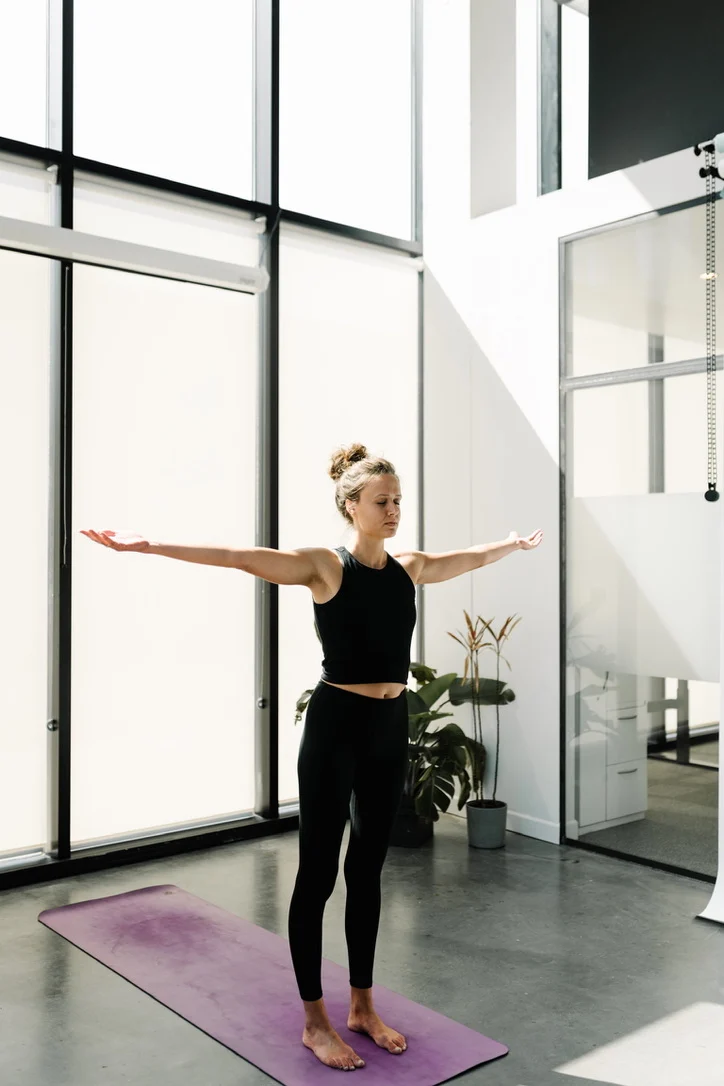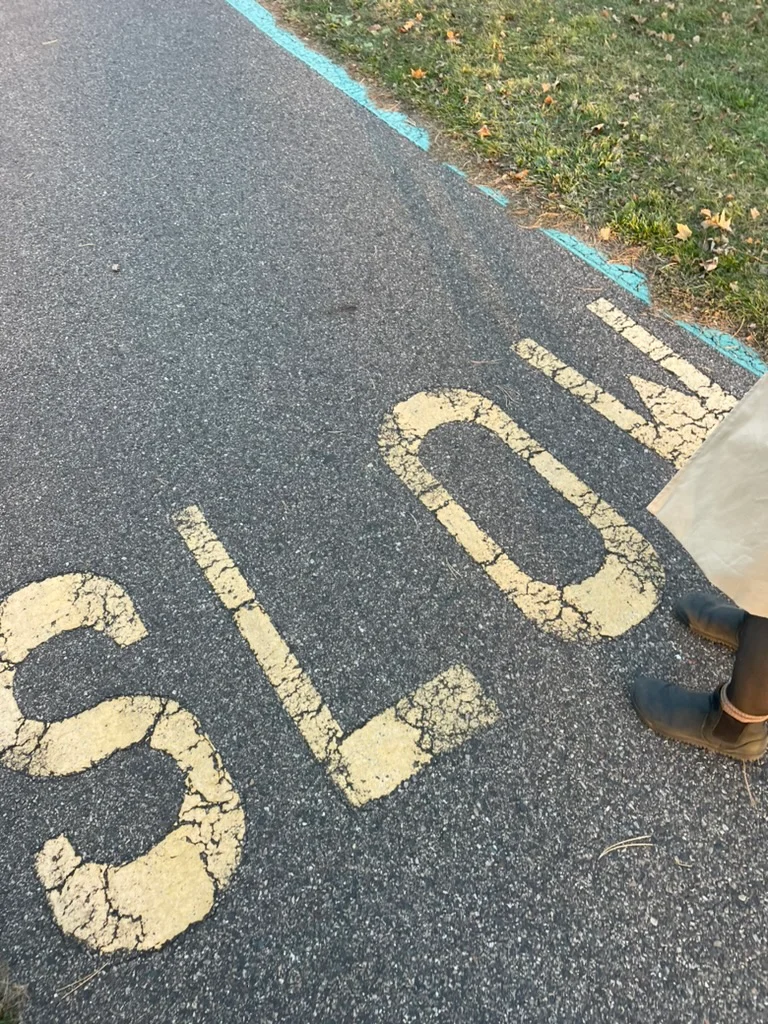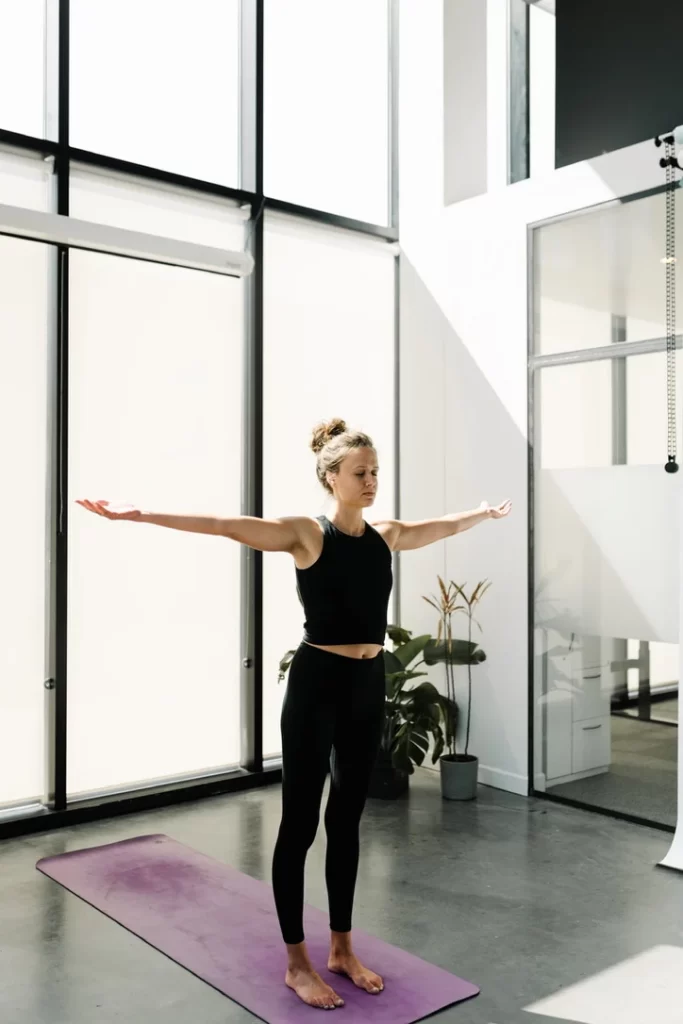On days when you find yourself running from meeting to meeting, your stress levels rise steadily through each hour, and you think you “don’t have time” for self-care. I’ve been there, too.
In my health coaching practice, I work with women business leaders. I’ve discovered that some embodied wellness practices take less than a minute to begin feeling the benefits of a stronger connection to your body.
These micro-moments of self-care aren’t just nice-to-haves—they’re evidence-based interventions that can significantly (positively) impact nervous system regulation, helping to prevent burnout before it starts.
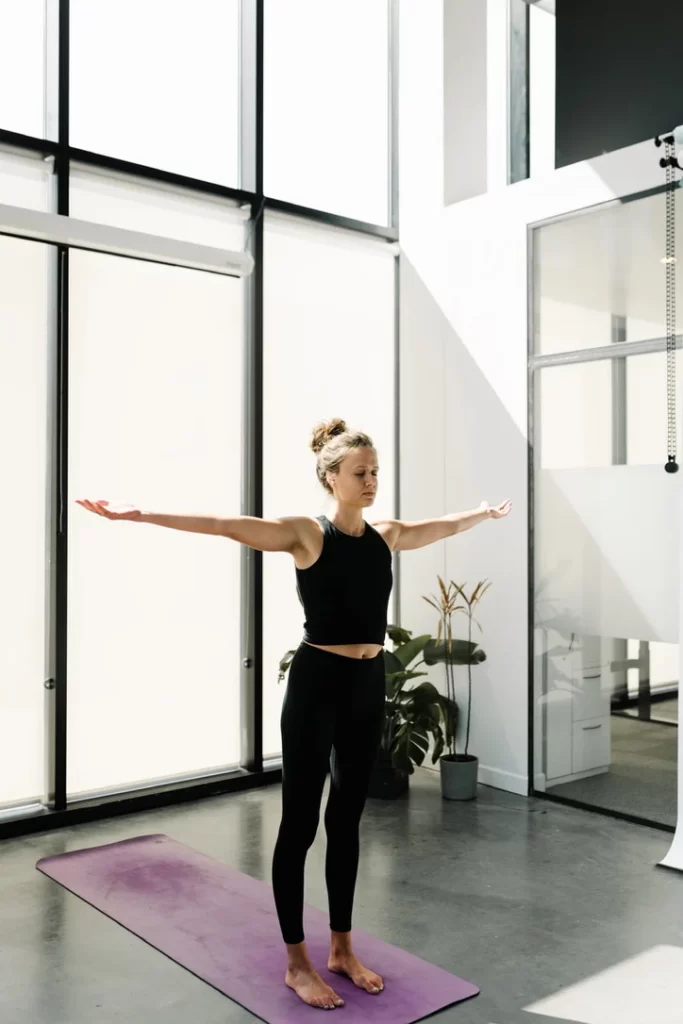
The Science Behind These Interventions
Research published in the National Library of Medicine shows that even brief grounding techniques can effectively regulate the autonomic nervous system and reduce stress.¹ Studies show that these techniques help shift the body from a “fight-or-flight” response to a more balanced state, activating the parasympathetic nervous system (Koniver, 2023).² For best practice, though, your body does need more time to shift fully into “rest and digest” mode. But these small “nervous system snacks” can help you drop into your body in the middle of a busy day.
Additionally, research from the National Center for Biotechnology Information demonstrates that grounding strategies can “help a person who is overwhelmed by memories or strong emotions,” providing immediate relief during stressful situations.³
Brief interventions are effective for busy professionals, as they provide accessible tools that can be incorporated into small moments of care.⁴
5 One-Minute Self-Care Practices for Busy Professionals
Here are five evidence-based practices you can implement in just 60 seconds or less:
1. Bilateral Stimulation (Butterfly Hug)
Time needed: 30-60 seconds
How to do it: Cross your arms over your chest, placing your right hand on your left shoulder and left hand on your right shoulder. Slowly tap alternating hands against your shoulders in a gentle rhythm. While tapping, take slow, belly breaths and notice the sensations in your body.
The science: Studies published in PubMed have shown that bilateral stimulation techniques can help regulate emotional responses by activating both brain hemispheres.⁵ This simple practice has been shown to reduce physiological arousal and help manage stress reactions.
When to use it: Before important meetings, during stressful conference calls (camera off!), or whenever you feel anxiety rising.
2. 5-4-3-2-1 Sensory Grounding Technique
Time needed: 60 seconds
How to do it: Notice 5 things you can see, 4 things you can touch/feel, 3 things you can hear, 2 things you can smell, and 1 thing you can taste. Name each one specifically, either mentally or in a whisper.
The science: Research published in the National Library of Medicine indicates that grounding techniques like this one can effectively interrupt anxiety by redirecting attention to the present moment, activating different neural pathways than those involved in worry or rumination.³
When to use it: When feeling overwhelmed with racing thoughts or transitioning between tasks requiring different types of attention.
3. Parasympathetic Activation Through Breath Regulation
Time needed: 30 seconds
How to do it: Place one hand on your heart and the other on your lower abdomen. Take three slow, deep breaths (inhale for 4 counts, exhale for 6 counts) while focusing on the sensation of your breath and the gentle pressure of your hands.
The science: Studies published in medical journals demonstrate that controlled breathing techniques directly impact the vagus nerve, increasing heart rate variability and promoting parasympathetic nervous system activity.⁶ Higher heart rate variability is associated with greater resilience to stress.⁷
When to use it: In moments of self-doubt, before giving feedback or presentations, or whenever you need a quick reset.
4. Alternate Nostril Breathing
Time needed: 45-60 seconds
How to do it: Using your right thumb, close your right nostril and inhale slowly through your left nostril. Then, close your left nostril with your ring finger, release your thumb, and exhale through your right nostril. Inhale through the right, then exhale through the left. Repeat 3-5 cycles.
The science: Research published in the National Library of Medicine has documented that alternate nostril breathing can balance autonomic nervous system activity, reduce stress markers, and improve mental clarity.⁸
When to use it: Before important decisions, while waiting for meetings to start, or whenever you need to clear mental fog.
5. Progressive Muscle Release
Time needed: 60 seconds
How to do it: Starting at your forehead, intentionally tense and then release each muscle group, moving down through your body—jaw, shoulders, hands, abdomen, legs, and feet. Spend about 10 seconds on each area, breathing deeply as you release the tension.
The science: Systematic reviews published in PubMed have shown that progressive muscle relaxation can effectively reduce sympathetic nervous system arousal and decrease cortisol levels, even when practiced for short durations.⁹
When to use it: After long periods of sitting, following tense interactions, or at the end of your workday before transitioning home.
3 More Practices To Deepen Your Body Connection (When You Have 5 Minutes)
When you have a few extra minutes, these slightly longer practices build on the one-minute options for regulation:
1. Brief Walking Meditation
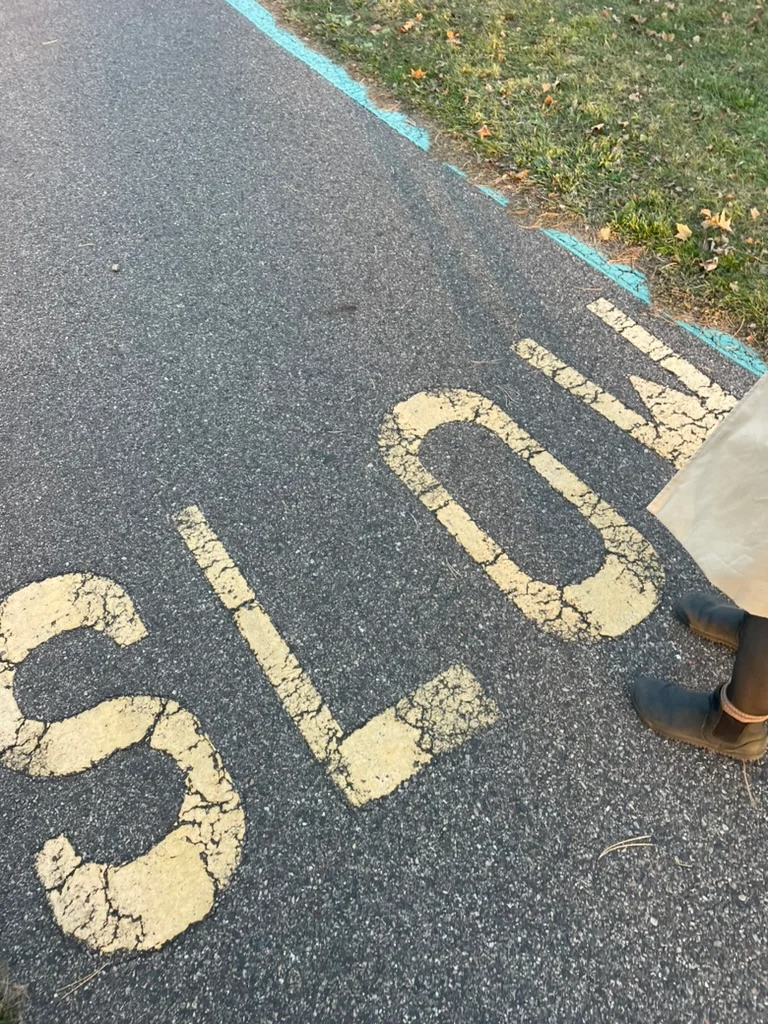
Take a walk, either outside or around your office. Focus on the sensation of your feet touching the ground with each step. Here’s the key differentiating factor that makes this especially grounding — notice the alternating pattern of right-left-right-left. Research shows can naturally regulate nervous system activity through bilateral stimulation.¹⁰
2. Body Scan and Stretch Reset
Sit comfortably and spend 3-5 minutes scanning your body from head to toe while breathing slowly and from your belly. Notice areas of tension without judgment, and breathe into those areas. Stretch your muscles. Studies from Mayo Clinic demonstrate that brief body awareness practices can significantly reduce stress markers.¹¹
3. Self-Compassion Break
Spend 3-5 minutes acknowledging a difficulty you’re facing, then place your hands over your heart and offer yourself words of kindness. Research published in PubMed shows that self-compassion practices can reduce cortisol levels and improve resilience.¹²
How to Integrate These Small Grounding Practices Into Your Day
The key to making these practices effective isn’t perfect execution—it’s making time to check in with your body second nature to you. Here are some ways to incorporate them into your workday:
- Habit-stack them: Attach these practices to existing habits, like doing bilateral tapping while waiting for your coffee to brew
- Set environmental cues: Place small reminder objects on your desk or create digital reminders
- Create transition rituals: Use these practices when moving between different types of work activities
- Normalize them: Practice visibly (when appropriate) to normalize self-care in your workplace
- Track them: Note which practices help most in different situations to personalize your approach
Remember, these micro-moments aren’t about adding one more thing to your to-do list. They’re about creating a sense of self trust that allow your nervous system to reset before stress accumulates to the point of overwhelm.
Your Next Step: One Week of Mini Self Care Moments
I invite you to experiment with these practices for one week. Choose one or two techniques that resonate with you and try implementing them at specific transition points in your day. Notice how these small shifts affect your energy, focus, and overall stress levels, if at all. Then tell me about it!
Would you like personalized guidance on creating a sustainable self-care practice that fits your unique needs and schedule? Book a free 30-minute consultation, and we’ll explore how these and other evidence-based approaches might support your health and wellbeing goals.
Cally Reed is a National Board Certified Health Coach (NBC-HWC) who specializes in helping busy professionals create sustainable well-being practices in their real lives. Through her practice, Gradual Shifts, she helps clients reconnect with their bodies’ wisdom to prevent burnout and build lasting resilience.
References:
¹ Koniver, L. (2023). Practical applications of grounding to support health. National Library of Medicine, PMC10105020.
² Chevalier, G., Sinatra, S. T., Oschman, J. L., Sokal, K., & Sokal, P. (2012). Earthing: Health implications of reconnecting the human body to the Earth’s surface electrons. Journal of Environmental and Public Health, 2012, Article 291541.
³ National Center for Biotechnology Information (NCBI). (2014). Trauma-Informed Care in Behavioral Health Services. Treatment Improvement Protocol (TIP) Series, No. 57.
⁴ Wolever, R. Q., Bobinet, K. J., McCabe, K., Mackenzie, E. R., Fekete, E., Kusnick, C. A., & Baime, M. (2012). Effective and viable mind-body stress reduction in the workplace: A randomized controlled trial. Journal of Occupational Health Psychology, 17(2), 246-258.
⁵ Sokal, K., & Sokal, P. (2011). Earthing the human body influences physiologic processes. Journal of Alternative and Complementary Medicine, 17(4), 301-308.
⁶ Brown, R. P., & Gerbarg, P. L. (2005). Sudarshan Kriya yogic breathing in the treatment of stress, anxiety, and depression: Part I—neurophysiologic model. Journal of Alternative and Complementary Medicine, 11(1), 189-201.
⁷ Svendsen, J. L., Osnes, B., Binder, P. E., Dundas, I., Visted, E., Nordby, H., Schanche, E., & Sørensen, L. (2016). Trait self-compassion reflects emotional flexibility through an association with high vagally mediated heart rate variability. Mindfulness, 7(5), 1103-1113.
⁸ Decker, J. T., Brown, J. L., Ashley, W., & Lipscomb, A. E. (2019). Mindfulness, meditation, and breathing exercises: Reduced anxiety for clients and self-care for social work interns. Social Work with Groups, 42(4), 308-322.
⁹ Ghaly, M., & Teplitz, D. (2004). The biologic effects of grounding the human body during sleep as measured by cortisol levels and subjective reporting of sleep, pain, and stress. Journal of Alternative and Complementary Medicine, 10(5), 767-776.
¹⁰ Chevalier, G., Sinatra, S. T., Oschman, J. L., Sokal, K., & Sokal, P. (2012). Earthing: Health implications of reconnecting the human body to the Earth’s surface electrons. Journal of Environmental and Public Health, 2012, Article 291541.
¹¹ Mayo Clinic. (2022). Mindfulness exercises.
¹² Neff, K. D., & Germer, C. K. (2013). A pilot study and randomized controlled trial of the mindful self-compassion program. Journal of Clinical Psychology, 69(1), 28-44.
¹³ Bishop, S. R., Lau, M., Shapiro, S., Carlson, L., Anderson, N. D., Carmody, J., & Devins, G. (2004). Mindfulness: A proposed operational definition. Clinical Psychology: Science and Practice, 11(3), 230-241.


